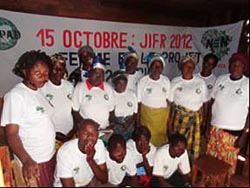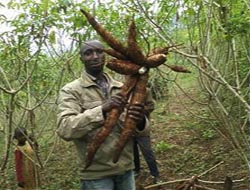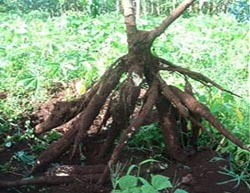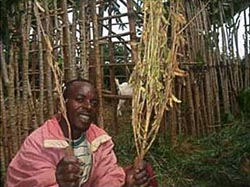The dissemination activities in DRC consist of various types, of which the large-scale dissemination activities (field days, exchange visits, international women’s day, radio broadcasts, etc.), organised by the NGO partners PAD, DIOBASS and SARCAF, are moments of sharing experiences and an opportunity for mutual enrichment.
Women, who are most involved in the agricultural activities, make use of the global days dedicated to women (15 October and 8 March) to discuss the N2Africa technologies with other women who are not in their group, and even with men who came to support them.
In Kabare, for instance, women accompanied by DIOBASS members of the village associations of Bugorhe, Kabamba, Cegera, Katana, Kavumu, Nyamakana, Cirheja, Lwiro and Kandere have exchanged ideas about the role of women in food security and the importance of N2Africa technologies to support food security in the country.
Women participating in this field day agree that the combined application of fertilisers, inoculum and good varieties followed by good land management gives higher yields in legumes as well as in intercropping. Fig 1 & 2.
 |
 |
Figure 1: International rural women’s day organised by development NGO partners: an opportunity to share experiences |
|
Figure 2: Results obtained by legume intercropping. The yield of cassava in intercropping with legumes contributes significantly to household food security and increasing revenues through the sale of the production surplus. |
 |
 |
In South Kivu the use of organic matter does not have to be demonstrated anymore; all farmers are aware that without organic amendments households are food insecure. However, one of the major challenges farmers are confronted with is declining livestock numbers due to insecurity, and the amount of organic matter to be applied. A profitable market for agricultural products remains a major challenge due to the level of production costs.
Certain farmers have developed protection mechanisms by keeping livestock in stalls close to the homestead. This mechanism has favoured the integrated crop – livestock system, in which farmers easily collect the manure to improve their field, while the field, in turn, produces livestock forage.
 |
Figure 3: A model to follow: If we want, we can produce more and reduce poverty This is Joseph Bisimwa, farmer in the lowlands between Kazinzi and Ikoma. In his left hand he holds an inoculated soyabean plant and in his right hand a non-inoculated plant. He is posing in front of his livestock shed with a goat, which was paid by the sale of his soyabean harvest. |
The integrated crop-livestock system means that livestock produces the manure to improve soil fertility and the field produces the fodder; the remainders of the harvest are also used to feed the livestock. Livestock and agriculture produce, in their turn, food for the household, and contribute to household income as well.
Dieudonné Mongane1, Adrien Chifizi1 and Freddy Baijukya2 (1 CIAT RDC, 2 CIAT Kenya), translation: Gatien Falconnier
